Scientists discover ancient caribou hunting site beneath Great Lakes
Loading...
Ancient caribou hunters were also apparently great architects.
A 9,000-year-old underwater hunting site discovered by scientists at the Alpena-Amberley Ridge beneath modern Lake Huron shows an elaborate arrangement of limestone rocks and artifacts used for hunting caribou.
Back then, the ridge was a piece of dry land that connected northeast Michigan to southern Ontario.
The submerged site consists of a stone lane where limestones are arranged on either side, running parallel to each other. The lane is funnel-shaped –broad in the beginning and then narrowing down.
The stones are arranged in a line, exploiting caribou's strange fascination with linear landscape, says John O'Shea, the Emerson F. Greenman Professor of Anthropological Archaeology at the University of Michigan and lead author of the study. The lane, dubbed "Drop 45 Drive Lane," has a dead-end, where most of the animals were hunted down. The stones alongside the lane were used for concealment.
In addition, outside the lane, three circular hunting blinds were built to further conceal the hunters and approach the animals.
The lane "is the most complex hunting structure found to date beneath the Great Lakes," notes the paper detailing the scientists' findings. Based on the orientation of Drop 45 and the way it sits on the landscape, researchers say they this lane was used by the hunters during the spring. Just uphill from Drop 45, one can see several other features that were used by hunters during various times of the year.
" from Drop 45 are oriented to intercept animals moving to the southeast in the autumn," Dr. O'Shea said in a press release. "This concentration of differing types of hunting structures associated with alternative seasons of migration is consistent with caribou herd movement simulation data indicating that the area was a convergence point along different migration routes, where the landform tended to compress the animals in both the spring and autumn."
The historical site has been preserved so well underwater that O'Shea compares the site to Pompeii. Had this site been situated on land, it would have become very difficult to preserve, as it could have been destroyed from activities such as farming even before archaeologists would have found it. This study emphasizes the importance of carrying out archaeological investigations of submerged prehistoric landscapes.
The paper titled "" appears in the journal Proceedings of the National Academy of Sciences.





